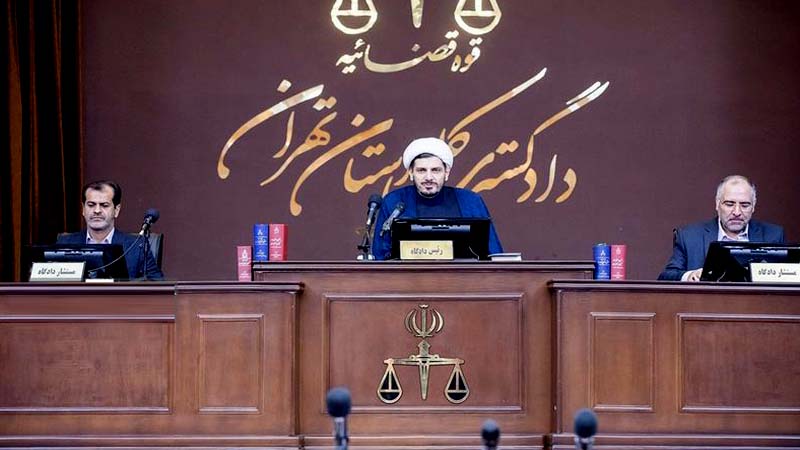The 22nd session of the trial court of 104 Mujahedin-e Khalq (MEK) members and the group as a legal entity was held in Tehran. The recent session was held at the 11th branch of the criminal court of Tehran province on Tuesday, November 6th, 2024. The court was presided by Judge Dehqani.
The judge commenced the hearing stating that the court is based on the criminal law procedure and according to legal documents, especially the criminal procedure law and the Islamic penal code, many of which are in accordance with Islamic jurisprudence and human rights documents, and with respect to all the rights of defense of the accused. “Even with the presumption of innocence and maintaining their defense rights, the court has been held in public,” he addressed the audience. “The right to defense is the right that any person who is being prosecuted can defend himself before a sentence is passed.”
The 22nd session of MEK trial heard the testimonies of two plaintiffs whose fathers were assassinated in the terrorist attacks of which the responsibility has been claimed by the MEK. Two former members of the MEK also showed up in the court as witnesses.
Mohammad Javad Hasheminejad is the son of Ayatollah Seyyed Abdul Karim, who was killed by the MEK’s suicide bombers in 1981. He told the court, “I have a book written by the accused in the third row of this trial, in which they state that in Iran the MEK assassinated 5 people who held the position of Ayatollah in the holy suicide way. They posted the pictures of the killers as members of the Mujahedin-e Khalq organization.”
As a survivor of one of the terrorist acts of the MEK, Hasheminejad established an institution together with a group of the victims’ families. “Anyone who is a victim of a terrorist crime is a member of this institution,” he said. “Nowhere in the world is it possible for an organization to commit terrorist acts and have an official office in European countries, and the host countries themselves have named this organization as a terrorist and terrorists who killed people in Iran, this is about the country. We are the exception. The reason why we started our institute was to collect the documents and evidence of these crimes and reflect them in the world. So that one or two generations ago they know what happened by these groups in the country and the world knows that Iran is one of the biggest victims of terrorism.”
Reihaneh Daftarian, the daughter of Abdul Hossein Daftarian, one of the victims of the prime minister’s office explosion in 1981. Reyhane Daftarian the court stand and said: “On August 30th 1981, I was about three and a half years old and I had two older brothers, 6 years old and 10 years old. What my mother told me was that they had talked to each other at 2 o’clock that day and had made a date for the afternoon. We had been taken to our grandmother’s house when one of his old students called at 4:00 PM and said that they were informed that the Prime Minister’s office had exploded.”
She continued: “Time passes and they can’t get any news from my father and they go to different hospitals, anyway, they were in very critical condition until tomorrow morning that it they understand that my father was killed in the explosion. He was stuck in the elevator.”
The Judge Dehghani stated that according to the bill that one of the witnesses has already presented to the court, 164 former members of the MEK have declared their readiness to appear in the court at this stage of the proceedings, in order to testify against the accused ones.
Ebrahim Khodabandeh, MEK ex-member and the director of Nejat Society read the statement signed by the former members titled “We testify”, for the audience. Dehqani also added, “Again, the court announces that all those who were harmed or know about the behavior and actions of the accused in this case, the first-tier accused, the MEK and all other accused, can file a complaint and if they have information, they can appear in the courtroom and testify.”
Hadi Shabani, former member of the MEK took the stand and testified about the terror teams who crossed Iranian borders in order to launch violent attacks. He joined the MEK in 1985. “I was 24 years old and I did not have a specific job,” he told the court. “After the victory of the revolution, many groups grew and each of them chanted slogans. We naturally thought that the MEK could bring the ideals that we had in our minds to the people, but it was not the case.”
In the MEK, Shabani was the unit commander. “We were supposed to target the march of 22 Bahman in Isfahan. We said that the operation may target civilians, Javad Khorasani or Ismail Mortazavi said: Everyone who participates in the march is a member of the regime and should be killed. There were 4 of us, one team for Shiraz and one team for Isfahan.”
The Prosecutor’s asked Shabani: “Regarding the mortar operations carried out by the MEK, did you not protest Rajavi that people and civilians were killed in these operations?”
Shabani said: “No one could question Rajavi in the MEK. Members’ minds are closed and they cannot ask such questions. Rajavi said several times in the meetings that several people may be killed in each operation and this is the price of the revolution and the people must pay the price of the revolution.”
Next session of the MEK’s trial will be held next Tuesday, November 19th, at 8 AM.


